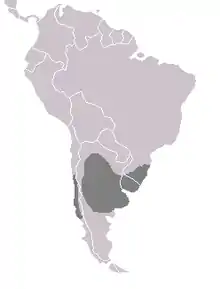Black-headed duck
The black-headed duck (Heteronetta atricapilla) is a South American duck allied to the stiff-tailed ducks in the tribe Oxyurini of the family Anatidae. It is the only member of the genus Heteronetta.
| Black-headed duck | |
|---|---|
.jpg.webp) | |
| Pair (male with black head) | |
| Scientific classification | |
| Kingdom: | Animalia |
| Phylum: | Chordata |
| Class: | Aves |
| Order: | Anseriformes |
| Family: | Anatidae |
| Genus: | Heteronetta Salvadori, 1865 |
| Species: | H. atricapilla |
| Binomial name | |
| Heteronetta atricapilla (Merrem, 1841) | |
 | |
| Range of black-headed duck | |
Description
This is the most basal living member of its subfamily, and it lacks the stiff tail and swollen bill of its relatives. Overall much resembling a fairly typical diving duck,[2] its plumage and other peculiarities indicate it is not a very close relative of these, but rather the product of convergent evolution in the ancestors of the stiff-tailed ducks.[3] It is a small, dark duck, the male with a black head and mantle and a paler flank and belly, and the female pale brown overall.
Distribution and habitat
They live in swamps, lakes and marshes in central Chile, Paraguay, Uruguay, northern Argentina and southern Brazil, feeding by dabbling on water plants and insects.
Breeding
The black-headed duck is an obligate brood parasite, meaning the female does not build a nest. It lays its eggs in the nests of other birds, instead, earning it the nickname cuckoo duck.[4] The hosts are particularly rosy-billed pochard (Netta peposaca), other ducks, coots (Fulica species), and occasionally even gulls (such as the brown-hooded gull) and birds of prey. Unlike some cuckoos, neither the chicks nor adults destroy the eggs or kill the chicks of the host. Instead, after a 21-day incubation, the ducklings fledge and after a few hours are completely independent, leaving their broodmates and fending for themselves. In contrast with the brood parasitic passerines, whose young are altricial, black-headed duck ducklings are precocial.
The black-headed duck is not considered threatened by the IUCN.[1]
References
- BirdLife International (2012). "Heteronetta atricapilla". IUCN Red List of Threatened Species. 2012. Retrieved 26 November 2013.CS1 maint: ref=harv (link)
- Livezey, Bradley C. (1986). "A phylogenetic analysis of recent anseriform genera using morphological characters" (PDF). Auk. 103 (4): 737–754.
- McCracken, Kevin G.; Harshman, John; McClellan, David A. & Afton, Alan D. (1999). "Data Set Incongruence and Correlated Character Evolution: An Example of Functional Convergence in the Hind-Limbs of Stifftail Diving Ducks" (PDF). Systematic Biology. 48 (4): 683–714. doi:10.1080/106351599259979. PMID 12066296. Archived from the original (PDF) on 14 June 2011.
- David Attenborough, Nature of the Cuckoo Duck, The Life of Birds, BBC Episode 9, 19 minutes ff.
External links
 Media related to Heteronetta atricapilla at Wikimedia Commons
Media related to Heteronetta atricapilla at Wikimedia Commons Data related to Heteronetta atricapilla at Wikispecies
Data related to Heteronetta atricapilla at Wikispecies
